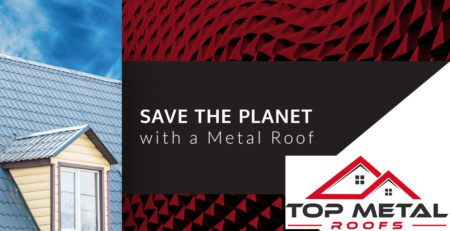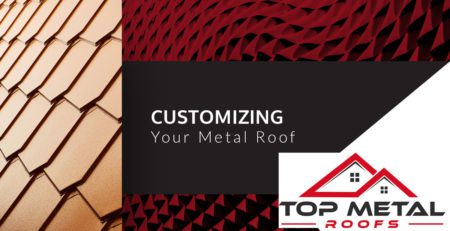How Much is the Average Cost to Tear Off and Replace a Metal Roof?
Your roof plays a major role in determining the structural integrity of your house. A good roof must be solid and resistant to extreme weather conditions. It must be durable enough to provide total protection for your family and property without the occasional leak and need for repair.
Because your roof experiences direct exposure to weather conditions, it wears down with time. Once your old roof starts showing signs of damage and weakness, it is time to consider a roof replacement. A compromised roof is a safety hazard and it exposes the rest of the house to moisture, mold, fungus, insects, rodents, and general structural damage.
The cost of tearing off and replacing your roof can seem unmanageable especially if you have no idea what the process involves. However, consulting a roofing expert can relieve the burden. Top Metal Roofs will guide you through all the steps of replacing your roof. We will help you make the right choice and install a durable roof that needs no maintenance or replacement in the near future.
Before you start estimating figures, you need to know the factors that affect the cost of roof replacement.
Factors Affecting Cost of Roofing

The amount of money you spend on your new roof will depend on the following factors:
Substrate
The cost of your roof will depend on the material you choose. Roofing materials are priced based on raw materials, production cost, panel design and their level of demand and supply. Galvanized steel and aluminum are often favored for residential roofing because they offer quality performance at affordable rates. Zinc, copper and stainless steel are exotic, offer superior performance but they are not popular due to their cost.
Roof design and physical location
Your roof’s architectural design will affect the amount of time and materials the contractor will require to complete the job. Features such as dormers, chimneys, skylights, windows, and valleys require more material and labor. A steep roof will require more equipment and time to complete than a flat roof. A flat roof may be cheaper to install but you may incur extra costs later in fixing drainage problems and general maintenance.
The physical location will determine accessibility and the equipment, permits, and licenses necessary for the job. Tight spaces and surrounding tree branches or power lines will require specialized equipment. Depending on where you live, special permits or licenses may be a legal requirement.
Stripping and disposal
Other than the cost of your new roof, you must consider the costs associated with tearing off and disposal of your old roof. Replacing your roof with a light metal roofing material may eliminate the cost of removing the old roof. Confirm from your area’s building code whether there are weight limitations for roofs.
Panel design
Your cost of roofing will also depend on your choice of panel design. Interlocking panels will cost you more due to their extensive manufacturing process, structural detail and the extra space they occupy during shipping. Panels with the four-side interlock feature cost more but provide a higher quality finish.
Underlayment
Underlayment is critical in providing an extra defense mechanism against weather elements. If you install your new metal roof over asphalt, you can use a breathable synthetic membrane. If you tear off the old roof, you will need an ice and water shield which is five times more costly than the breathable synthetic membrane
Coatings
Also known as finishes, your choice of coating has a direct relationship with the cost and ultimately the lifespan of your new roof. Polyester based paint is cheap but it also has a limited lifespan. Polyvinylidene Fluoride (PVDF), the industry’s gold standard, is pricey because it is chalk and fade resistant, adhesive and exceptionally durable.
Cost of Labor
Some roofing contractors will engage the services of cheap subcontractors for the job. However, accomplished contractors command higher rates because they invest in staff training programs, project managers, liability insurance and WSIB premiums. Project managers are especially important because they provide professional oversight for proper roof installation, insulation and water management.
How to Estimate Your Roofing Costs
When calculating your roofing costs, the roofing material will determine the largest portion of your budget. The remainder of the estimated budget will depend on other factors such as:
- How complex your roof is
- number of stories
- number of chimneys
- the geographic location
- requisite permits and taxes
- roofing company
You can use a roof cost calculator to estimate your roof replacement costs.
How to Use the Roof Cost Calculator
The roof cost calculator will help you estimate your roofing costs in three simple steps. Fill in the necessary information, and the calculator will do the rest.
Step 1: Fill in the total area of your house
This is the size of your entire house in square feet when measured from the exterior. You can estimate it based on the length and width of your house. Length is the distance along the long side while the width is measured on the short side.
Step 2: Choose the number of stories
This is the number of floors occupied by your house. Your house is single-story if it only has one floor and two-story if it has two floors.
Step 3: Choose the slope on your roof
Also known as the pitch, it refers to how steep your roof is. It is the vertical rise of the roof for every 12 inches of measured horizontally. A steep or high slope rises 12 inches for every 12 inches of horizontal length. A roof with a 6-inch vertical rise for every 12-inch horizontal length has a moderate slope.
The roof cost calculator is very effective in providing roofing estimates. However, the following factors are excluded from the estimation.
- Mandatory taxes for removal and installation of a new roof
- Replacement of a damaged structure
- Other roofing systems that may require replacement
- How geographic location affects pricing
- Quality of roofing materials from different manufacturers
Additional Roofing Costs
When installing your new metal roof, you may incur some extra costs due to some of the factors below.
Removing the old roof
The extent of the damage on your old roof will determine whether you will remove it or not. If it is in relatively good condition, you can place a new metal roof on top of the old one. If your roof already has two layers of shingle or it is too damaged, you will have to incur extra costs to remove it before installing a new one.
Trusses and rafters
Trusses and rafters are necessary for roof support. If they are not strong enough, the roof cannot withstand the elements. Weak trusses and rafters must be repaired or replaced before installing a new roof.
Algae and fungus
If you live in a place with high humidity or rainfall, using algae resistant shingles may be a worthwhile investment. They are resistant to damage and discoloration, and they increase your roof’s lifespan. They cost 15% more than regular shingles.
Pitch
During installation, the safety of the crew is crucial. A remarkably steep pitch will require extra precaution and extra steps in the installation process, which translates to extra cost.
Why Your New Roof Should Be Metal
It is not economically viable to replace your roof every few years. How often you do it will depend on your choice of roofing material. Here are some reasons why metal is the best option.
Durability and longevity:
Metal roofs can last for more than 50 years while other materials last for 20 years. They are resistant to corrosion, do not crack on impact and do not require routine maintenance.
Weight:
Compared to concrete and clay tiles, metal is lighter and does not require extra structural support. Additionally, you can install a metal roof over an existing one.
Beauty and elegance:
Metal roofing is available in hundreds of colors and finishes that match any style. You can choose metal roofing that imitates slate, tile, fiberglass shingles, and natural wood shakes.
Fire resistance:
Your metal roof is safe, does not burn and will not ignite from a wildfire or a lightning strike.
Installation in any weather:
You can install your metal roof even in winter. It does not loose shape or strength even when exposed to low temperatures.
Resistance to fungus and moss:
Fungus and moss do not affect metal. It is, therefore, ideal for roofing in areas that are prone to growth of fungus and moss.
Energy efficiency:
Metal reflects heat from the sun, thereby reducing your cooling costs by between 10 -25%.
Environment-friendly:
Metal roofing contains between 25 – 95% recycled materials. After being used, metal is 100% recyclable.
Shedding rain and snow:
Snow, ice and rain slide off metal roofs smoothly because the panels are hard and sleek. This prevents the formation of ice dams.
Our Roofing Experts can Assist You
Tearing off your old roof and installing a new one is a major investment. It is also a construction project that involves more than just the homeowner. You may need to fill out applications, obtain permits and licenses, observe neighborhood regulations and put up with noise from the construction. It is therefore imperative that you replace your old roof with a new metal roof to avoid dealing with such problems every few years. Contact Top Metal Roofs at 647-470-7161 for a lasting solution.



